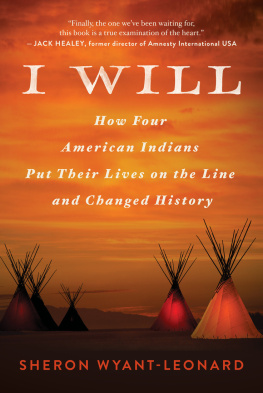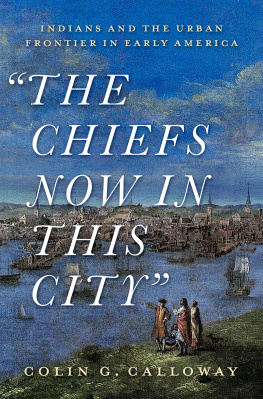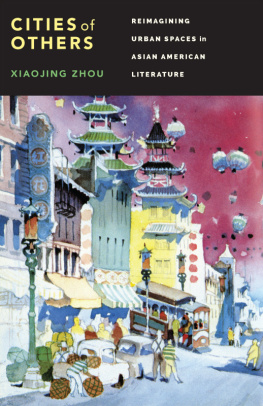Recent Titles in Native America: Yesterday and Today
Bruce E. Johansen, Series Editor
The Native Peoples of North America: A History
Two Volumes
Bruce E. Johansen
Daughters of Mother Earth: The Wisdom of Native American Women
Barbara Alice Mann, editor
Iroquois on Fire: A Voice from the Mohawk Nation
Douglas M. George-Kanentiio
Native America, Discovered and Conquered: Thomas Jefferson,
Lewis & Clark, and Manifest Destiny
Robert J. Miller
The Praeger Handbook on Contemporary Issues in Native America
Volume 1: Linguistic, Ethnic, and Economic Revival
Volume 2: Legal, Cultural, and Environmental Revival
Bruce E. Johansen
The Tainted Gift: The Disease Method of Frontier Expansion
Barbara Alice Mann
Frontier Newspapers and the Coverage of the Plains Indian Wars
Hugh J. Reilly
Lethal Encounters: Englishmen and Indians in Colonial Virginia
Alfred A. Cave
Reservation Capitalism: Economic Development in Indian Country
Robert J. Miller
Land and Spirit in Native America
Joy Porter
Resource Exploitation in Native North America: A Plague upon the Peoples
Bruce E. Johansen
American Indian Identity: Citizenship, Membership, and Blood
Se-ah-dom Edmo, Jessie Young, and Alan Parker
Urban American Indians
Reclaiming Native Space

Donna Martinez, Grace Sage,
and Azusa Ono
NATIVE AMERICA: YESTERDAY AND TODAY
Bruce E. Johansen, Series Editor

Copyright 2016 by Donna Martinez, Grace Sage, and ABC-CLIO, LLC
All rights reserved. No part of this publication may be reproduced, stored in a retrieval system, or transmitted, in any form or by any means, electronic, mechanical, photocopying, recording, or otherwise, except for the inclusion of brief quotations in a review, without prior permission in writing from the publisher.
Library of Congress Cataloging-in-Publication Data
Names: Martinez, Donna, author. | Sage, Grace, author. | Ono, Azusa, author.
Title: Urban American Indians : reclaiming native space / Donna Martinez, Grace Sage, and Azusa Ono.
Description: Santa Barbara, California : Praeger, an imprint of ABC-CLIO, LLC, [2016] | Series: Native America: yesterday and today | Includes bibliographical references and index.
Identifiers: LCCN 2016016774 (print) | LCCN 2016019712 (ebook) | ISBN 9781440832079 (hardcopy : alk. paper) | ISBN 9781440832086 (ebook)
Subjects: LCSH: Indians of North AmericaUrban residenceUnited States. | Indians of North AmericaEthnic identity. | Indians of North AmericaSocial conditions.
Classification: LCC E98.U72 M47 2016 (print) | LCC E98.U72 (ebook) | DDC 973.04/97dc23
LC record available at https://lccn.loc.gov/2016016774
ISBN: 9781440832079
EISBN: 9781440832086
20 19 18 17 161 2 3 4 5
This book is also available as an eBook.
Praeger
An Imprint of ABC-CLIO, LLC
ABC-CLIO, LLC
130 Cremona Drive, P.O. Box 1911
Santa Barbara, California 93116-1911
www.abc-clio.com
This book is printed on acid-free paper 
Manufactured in the United States of America
Contents

Donna Martinez
Grace Sage
Azusa Ono
Donna Martinez
Grace Sage
Azusa Ono
Series Foreword

A lthough popular stereotypes usually place them on reservations (and often a century or two in the past), more than three-quarters of American Indians within the United States now live and work in cities, bound by community ties both rural and urban, with their own hybrid histories and cultural attributes. This statistic may come as a surprise to many readers because very little has been written about the urbanization of Native America. Urban American Indians: Reclaiming Native Space is one of few books that examine urban American Indians as a group, in historical and social context.
Vine Deloria Jr. is quoted in the Introduction of this work, from God Is Red : Indians are unable to get non-Indians to accept them as contemporary beings. Non-Indians either cannot or will not respond to the problems of contemporary Indians. They insist on remaining in the last century [the nineteenth] with old Chief Red Fox, whoever he may really be, reciting a past that is basically mythological, thrilling, and comforting. This book is an enormous corrective to that stereotype.
For many American Indians, urban living has sometimes been a matter of choice, as well as necessity, most often related to the possibility of employment. Even as many reservation communities have revived because of economic development (often related to casinos and related businesses), urban Indian communities retain their vibrancy.
This book couches todays urbanization in historical context, pointing out that American Indians built the first cities on the continent at such places as Cahokia, Mesa Verde, Chaco Canyon, and Taos Pueblo. When the Spanish first found it, Tenochtitlan, with an estimated 200,000 people, was larger than London, England. It was without question the largest city the Spaniards had ever seen. Mexico City, on the same location today, is among the worlds largest urban areas.
Today, some reservations have been surrounded by expanding urban areas. Witness the Muckleshoots of Western Washington, whose reservation between Seattle and Tacoma was rural when it was established in the 1860s. It is now largely urban, with a thriving casino and other businesses that draw clientele from surrounding cities, with profits going into reservation revitalization (schools, housing, and more).
In an electronic age, ethnic identity is not bound by a particular place, although Native people often associate culture with physical location. As the authors state in this books Introduction, People in various locations are linked by long-distance nationalism to an ancestral land base and government. The external borders of nations and reservations differ from internal borders that unite feelings of territorial, psychological, and spiritual identities. Cities have also provided fertile ground for Native activism. The American Indian Movement (AIM) was founded in Minneapolis as a reaction to police mistreatment, for example.
Urban activism arrived with some irony, because federal-government policy sent Native peoples to cities to assimilate them, forgetting that influence of culture flows both ways. I recall visiting a powwow on Chicagos Navy Pier with several thousand people, many of them non-Indians. No one, it seemed, was paying attention to assimilation theory formulated by anthropologists and sociologists in the 1910s, which had assumed that American Indians would cease to identify with their ancestral peoples once they had moved to urban areas. They assumed that a change of location would wipe the cultural slate clean. The same academics seem not to have examined immigrants from Europe who had moved thousands of miles to America and preserved their cultures.
Yet, this book comments, when American Indians moved to urban areas, they immediately created both tribal and intertribal groups in cities to support the continuance of American Indian cultural traditions for their families. Recent scholarship has questioned whether assimilation theories are accurate or just a reflection of the continual colonial predictions of vanishing Indians. Assimilation is not inevitable. Native cultures are not static but continue to change according to circumstances, as all cultures do. Developing inauthentic Natives is the desired outcome of assimilation. This book finds, with abundant support, that The story of urban American Indians is not one of doom and gloom but rather an engaging story of cultural resilience and survival.










